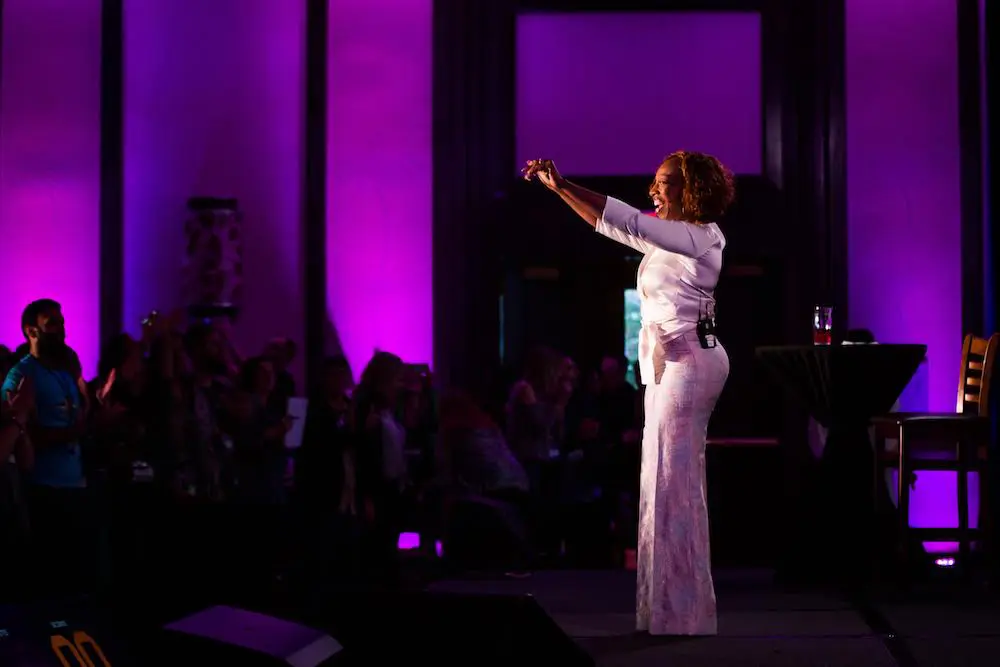Um… Er… So… You know… Well… Like… Right?…
Filler words are the best crutches, aren’t they? They’re easy to lean on when you need a moment to collect your thoughts.
However, when they’re sprinkled all over your talk, it’ll most likely distract your audience from your message and possibly diminish your credibility.
Now, imagine this: instead of using filler words, take a few seconds and stay silent.
It’s the last thing you would think of doing, right? It’s a paradox if you really think about it—a noticeable silence in the middle of your presentation.
But it may just be the pause—a silent mic drop, if you will—you need to make your message unforgettable.
This is what’s called “the pregnant pause.”
What’s a pregnant pause?
Don’t get thrown off by the word “pregnant.” In this context, it has nothing to do with babies.
In fact, the word itself stems from the 15th century, being defined as “full of meaning.” So as a pregnant body is full of meaning with a little human, a pregnant pause is full of meaning with silence.
It’s when you “give a statement space to land and breathe in the listener before you move any further,” says Lisa Nichols, the CEO of Motivating the Masses and trainer of Mindvalley’s Speak and Inspire Quest. She explains it’s when you’re okay to just stop… and let it land.
Whether to an audience of one or a thousand, you may already be doing this unknowingly. What’s more, there are quite a number of benefits to taking a moment. Here are a few:
- It gives you time to be mindful, to breathe, and to allow more oxygen to flow to your brain
- It prevents stream-of-conscious babbling and the use of filler words
- You’re able to structure your thoughts
- You can do a pulse check and see if your audience is bored or not
- It breaks up the monotony of continuous speaking and creates drama for excitement
By understanding its power and how to properly utilize it, you’ll be able to intentionally increase the impact of your message on your audience.
Every time you do it, you’ll get value. And every time you see the benefit of it, you’re committed to doing it another time.
— Lisa Nichols, trainer of Mindvalley’s Speak and Inspire Quest
So… [pregnant pause] …let’s get to it.
How Does Your Brain React to a Pregnant Pause?
“Hush, just stop…” Cue the pregnant pause—man, does Britney Spears know how to get our attention in her song, Stronger, or what.
Interestingly, there’s science to prove its effectiveness, especially on your brain.
One, in particular, comes from the Stanford University School of Medicine. This study looked into how the brain responded to a few seconds of silence during a musical piece.
The results came back with two main findings:
- The pregnant pause allowed the listeners to take in the piece in bits so they can remember it.
- It triggered the listener’s ability to pay close attention and expect what comes next.
This applies to speeches or conversations as well.
Another study published in Plos One Journal looked at how the brain interprets the pregnant pause in the conversation, specifically when it comes to saying “no” immediately or after a moment. The researchers found that when there was a long gap between the action (requests, offers, proposals, or invitations) and the response “no,” the brain reacted more positively than if the “no” was immediate.
“Remember, as you’re saying things, as you’re giving statements, your listener is actually digesting what you’re saying, replaying a bit of what you said, and then trying to take in what you said,” Lisa points out. “When you stop for a moment and you give them the space, they get to take it in.”
It’s as the saying goes: silence is golden.

How do you do a pregnant pause?
For many, silence can be scary, and more often than not, they won’t bother using a pregnant pause. So first things first, in order to get to the orator level of Lisa, give yourself permission to take a moment.
Now, here are three steps to take your communication skills to the next level:
1. Know when to pause
When you’re ready to use a pregnant pause, consider using it to highlight what you just said or what’s coming next. Here are three examples of when a pause is most effective:
- Presenting key points, facts, or statistics. Oftentimes, these come with vital data and numbers. By pausing, you allow your audience to absorb the significance of the information they just heard.
- Asking or being asked questions. Taking a few seconds to respond gives you time to think before you speak. It also prevents you from using filler words.
- During a buildup or a suspenseful part of your story. Comedians are known to use this before they present their punchline or before they move on to the next joke.
That said, keep in mind that you shouldn’t overdo it and fall into what Lisa refers to as “pregnant pause overkill”.
2. Find your rhythm
Lisa recommends your pregnant pauses be “inside of a rhythm where you’re talking and you’re speaking and you’re giving value and you’re taking them to a place they haven’t gone before.”
Think back to the last concert you went to. Remember how you felt so connected, in the moment, to the performer and the atmosphere? That’s because music typically includes principles of patterns, rhythms, familiarity, and originality. And that’s what makes it so engaging.
As a speaker, you can use features and techniques from music to keep your audience captivated. Make your speech as if you’re making music—consider the rhythm, the cadence, and the intonation. And when you orchestrate them together, you’ll be a master at delivering your message.
3. Know your audience
Having a one-on-one conversation with your friend is a whole lot different than presenting to board members or speaking in front of a large audience, like those at Mindvalley’s A-Fest.
Different audiences have different vibes, so it’s incredibly important to know how much of a particular technique they can handle.
Although silence can be scary for some speakers, Lisa encourages you to show them love from your overflow. “The space between the words can feel like dead silence,” she says, explaining that it’s simply “an opportunity for them to just take more of you in.”
Let your pause do the talking
Your voice is one of the greatest assets you have. When you use it to breathe life into the stories you tell, you’ll find yourself articulating your message that captures people’s attention. And by honing in on techniques, like the pregnant pause, magic happens.
The pregnant pause is a gift to your listener and it’s a gift to yourself.
— Lisa Nichols, trainer of Mindvalley’s Speak and Inspire Quest
You can look for inspiration from great speakers, like Barack Obama or Steve Jobs. Or you can head over to Mindvalley and learn from one of the greats—Lisa herself.
Sign up for a free Mindvalley account today to unlock preview lessons from Speak and Inspire, daily meditations, and a global community that will help you step into your most powerful voice.
Welcome in.









